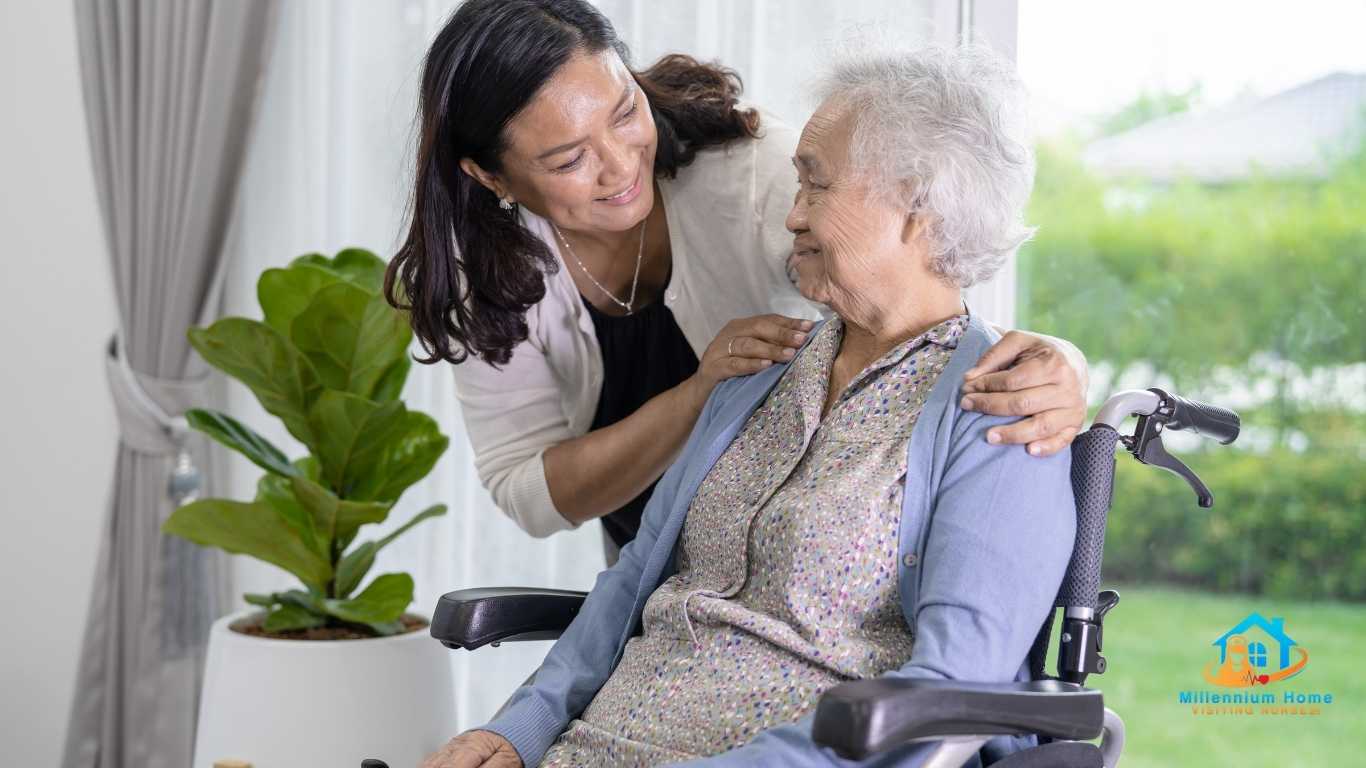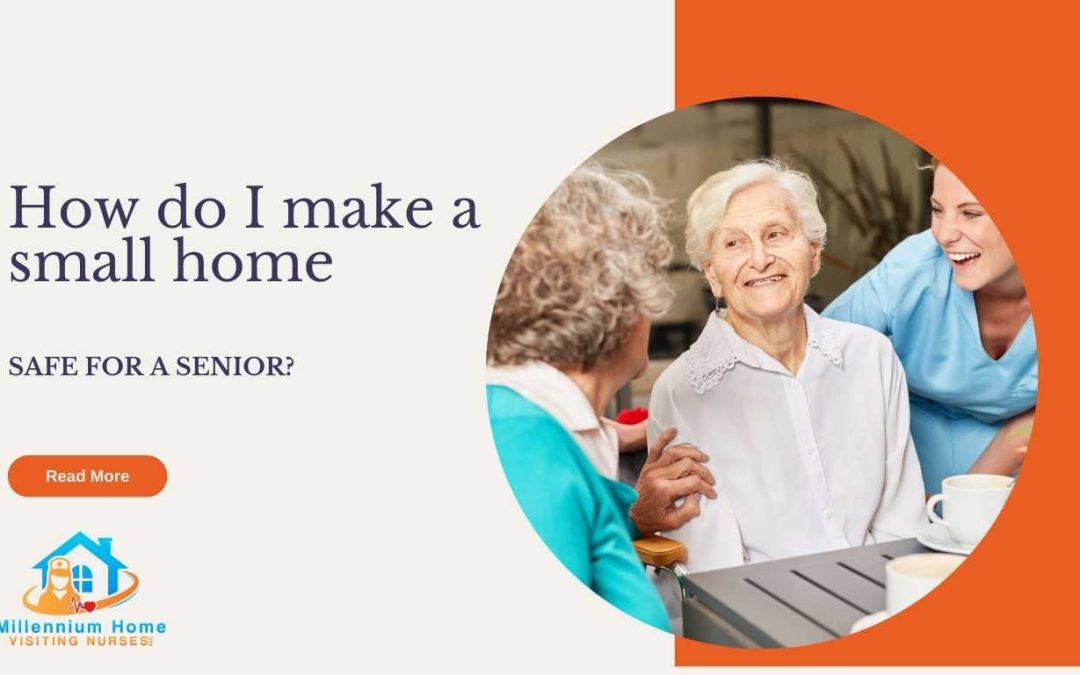For many seniors, staying in their own home represents independence and comfort. However, as mobility decreases and health concerns increase, the home environment, especially a smaller one can present unexpected hazards. According to the CDC, one in four Americans aged 65+ falls each year, with 3 million emergency room visits resulting from these incidents. The good news is that with thoughtful modifications and proper planning, even the smallest homes can become safe havens for elderly residents.
How do I make a small home safe for a senior?
At Millennium Home Visiting Nurses, we’ve helped hundreds of Maryland seniors remain safely in their homes through our specialized care services. Our team of licensed caregivers has gathered extensive knowledge about creating secure environments in homes of all sizes. This comprehensive guide shares our professional insights on transforming a small home into a safe space for seniors.
Assessing Fall Risks in Small Homes
Before making modifications, conducting a thorough assessment of potential hazards is essential. Small homes present unique challenges, as limited space often means more obstacles in closer proximity.
The most common fall hazards in compact living spaces include:
- Cluttered pathways and narrow walkways
- Poorly lit areas, especially hallways and staircases
- Loose rugs or uneven flooring transitions
- Furniture that obstructs movement or lacks stability
- Bathrooms with slippery surfaces and limited grab supports
- Kitchen items stored too high or too low, requiring reaching or bending
When assessing a small home, pay special attention to transitional areas the spaces between rooms often become collection points for clutter in smaller homes. Doorway thresholds deserve particular scrutiny, as even minor lips or uneven surfaces can cause trips.
Our professional caregivers recommend conducting this assessment both during daylight and evening hours, as lighting conditions significantly impact visibility and safety. Areas that seem perfectly navigable during bright daylight may become hazardous in dimmer evening light.
“What many families don’t realize is that small homes actually offer some safety advantages,” notes Sarah Chen, our lead fall prevention specialist. “With proper organization, smaller spaces mean shorter distances to travel between rooms and potentially fewer steps required for daily activities.”

Essential Modifications for Small Home Safety
Converting a small home into a senior-friendly environment doesn’t require extensive renovations. Strategic modifications can dramatically improve safety while preserving the home’s character and functionality.
Bathroom Safety Improvements
The bathroom consistently ranks as the most dangerous room for seniors due to slippery surfaces and hard fixtures. In small bathrooms, space constraints make safety features even more crucial:
- Install grab bars near the toilet and in the shower/tub area. Position them at heights appropriate for the senior’s specific needs, generally 33-36 inches from the floor.
- Consider converting tubs to walk-in showers with zero-threshold entries, eliminating the need to step over barriers. For homes where this isn’t feasible, tub cut-outs provide a more affordable alternative.
- Raise toilet seats by 3-5 inches to reduce strain when sitting and standing. Toilet frames with armrests offer additional support in compact bathrooms where wall-mounted grab bars might be impractical.
Apply non-slip mats or treatments to all floor surfaces, especially in and around the shower area.
Living Area Adaptations
Small living spaces require careful furniture arrangement to support safe movement:
- Create clear pathways at least 32 inches wide throughout the home. This may necessitate removing or relocating furniture pieces that obstruct natural traffic patterns.
- Secure all area rugs with double-sided tape or non-slip backing, or consider removing them entirely.
- Adjust furniture heights to facilitate easier transitions from sitting to standing. Chairs with firm cushions and sturdy armrests are ideal.
- Install additional lighting, particularly in hallways, stairwells, and corners. Motion-sensor night lights provide illumination without requiring the senior to locate switches in the dark.
- For homes with stairs, ensure handrails extend the full length of the staircase and are securely anchored. Consider applying high-contrast tape to stair edges to improve visibility.
Smart Technology Solutions for Senior Safety
Modern technology offers valuable tools for enhancing safety in small homes without consuming precious space.
Medical Alert Systems
Today’s medical alert systems go far beyond the traditional “I’ve fallen and can’t get up” pendants. Newer versions include:
- Fall detection technology that automatically summons help
- GPS capabilities for seniors who remain active outside the home
- Water-resistant wearables that can be used in the shower
- Systems that integrate with smartphones and smart home features
The compact nature of these devices makes them ideal for smaller homes, providing comprehensive coverage without adding clutter.

Automated Systems
Smart home technology can substantially improve safety for seniors living in small spaces:
- Voice-activated systems allow seniors to control lighting, temperature, and some appliances without physical movement.
- Automated medication dispensers provide audible and visual reminders when it’s time to take medications, reducing the risk of missed doses or accidental overdoses.
- Motion-sensor lighting ensures proper illumination in critical areas like hallways, bathrooms, and stairways without requiring manual operation.
- Video doorbells with two-way communication enable seniors to screen visitors without rushing to the door, reducing fall risks from hurried movements.
“When implementing technology solutions, simplicity is key,” emphasizes Michael Roberts, our technology integration specialist. “The best systems require minimal interaction while providing maximum protection.”
Creating Safe Storage Solutions in Limited Spaces
Small homes often struggle with storage limitations, which can lead to clutter a significant fall hazard for seniors. Strategic organization is essential for maintaining both accessibility and safety.
Kitchen Organization
The kitchen presents unique challenges in small homes, as frequently used items must remain accessible without requiring risky reaching or bending:
- Reorganize cabinets to place everyday items at waist to shoulder height.
- Install pull-out shelving in lower cabinets to eliminate the need for deep bending.
- Use lazy Susans in corner cabinets to bring items to the front with minimal effort.
- Replace standard cabinet hardware with larger, easier-to-grip handles that accommodate arthritic hands.
- Consider open shelving for the most commonly used lightweight items to eliminate cabinet door manipulation.
Bedroom and Living Area Storage
Throughout the rest of the home, focus on creating organization systems that support safety:
- Place frequently worn clothing in drawers at waist height and install closet organization systems that bring items within easy reach.
- Use bedside tables with drawers or shelves to keep essentials like glasses, medications, and water within arm’s reach.
- In living areas, incorporate furniture pieces that offer hidden storage to reduce visible clutter while maintaining easy access to necessary items.
Label storage containers clearly with large print for seniors with visual impairments.
Daily Living Adaptations for Senior Safety
Beyond physical modifications, adjusting daily routines and habits significantly contributes to home safety. These adaptations are particularly important in small spaces where margin for error is reduced.
Movement and Activity Adaptations
Small changes in how seniors approach daily activities can prevent accidents:
- Encourage sitting while dressing, particularly when putting on pants, socks, and shoes.
- Keep a cordless phone or cell phone within reach at all times, perhaps using a belt clip or lanyard for constant access.
- Use reaching tools to retrieve items from high shelves or the floor without stretching or bending.
- Plan activities to minimize trips up and down stairs, grouping tasks to reduce the number of level changes required throughout the day.

Clothing and Footwear Considerations
What seniors wear significantly impacts their safety:
- Select non-slip, supportive footwear with secure fastening mechanisms (Velcro often works better than laces for those with arthritis).
- Choose clothing that fits properly and doesn’t drag on the floor or restrict movement.
- Avoid long robes or nightgowns that might cause tripping, especially during nighttime bathroom visits.
- Consider elastic waistbands and front-closing garments for easier dressing with less bending and twisting.
Professional In-Home Care Support
While home modifications are essential, professional caregiving services provide an additional layer of protection for seniors aging in place. Personal care aides offer crucial support in several areas:
Safety Monitoring and Assistance
Trained caregivers from Millennium Home Visiting Nurses are educated to spot potential hazards that family members might overlook. Regular home safety reassessments help identify new concerns as a senior’s condition evolves.
Our caregivers assist with mobility, transfers, and personal care routines, substantially reducing fall risks during these vulnerable activities. They can also help with daily household tasks that might otherwise tempt seniors to engage in risky behaviors like climbing on step stools or carrying heavy items.
Medication Management
Medication errors represent a significant safety concern for seniors. Our professional medication management services include:
- Organizing prescriptions and over-the-counter medications
- Providing timely reminders for scheduled doses
- Monitoring for side effects that might impact balance or cognition
- Coordinating with healthcare providers to ensure medication regimens remain appropriate

Conclusion: A Proactive Approach to Small Home Safety
Creating a safe environment in a small home requires thoughtful planning and ongoing assessment, but the rewards are worth it. Independence, comfort, and peace of mind are immeasurable. By implementing the strategies outlined in this guide, families can significantly reduce the risk of falls and other home accidents for their senior loved ones.
At Millennium Home Visiting Nurses, we understand the unique challenges of maintaining safety in homes of all sizes across Rockville and greater Maryland. Our team of licensed caregivers specializes in creating personalized care plans that address each client’s specific needs and home environment.
If you’re concerned about a senior loved one’s safety at home, we invite you to contact us for a complimentary home safety assessment. Our experienced professionals will evaluate your loved one’s living space, identify potential hazards, and recommend appropriate modifications and services to improve safety and quality of life.
Don’t wait for an accident to happen take proactive steps today to ensure your loved one’s home remains a safe haven for years to come.


Recent Comments